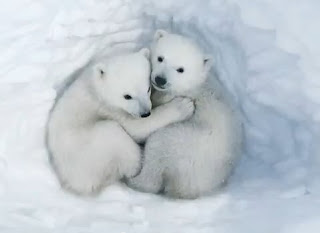The polar
bear, Ursus
maritimus, or the sea bear, evolved about 200,000 years ago from brown bear
ancestors. They are superbly adapted for survival in the Far North.
http://www.actionbioscience.org/environment/derocher.html
Photograph by Norbert Rosing
Polar bears range throughout the Arctic in areas where
they huntseals
at openings in sea ice called leads.
Five nations have polar bear populations: the United States (Alaska), Canada,
Russia, Denmark (Greenland), and Norway.
From Sierra Club
At the March 2009 range states meeting of the five
polar bear nations, scientists agreed that climate change is the single biggest
threat facing polar bears.
The Arctic is experiencing the warmest air temperatures in four centuries. The Arctic has experienced warm
periods before, but the present, rapid shrinking of sea ice is unprecedented.
Scientists predict a mostly ice-free Arctic summer by 2040 if present trends continue.
From Peas in a pod, Peapod's
blog
Today's polar bears are facing rapid loss of the sea
ice where they hunt, breed, and, in some cases, den. Changes in their
distribution or numbers affect the entire arctic
ecosystem.
Scientists believe that we still have time to save polar
bears if we significantly reduce greenhouse emissions within the next few years.
Yet it will take 30 to 40 years for changes reversing the warming trend to
show.
Polar bears are finding too much open water. In 2004, four polar bears drowned off the coast of Alaska when trying to swim to the pack
ice.
Nikita, Ovsyanikov. Polar Bears : Living with the
White Bear / Nikita Ovsyanikov. Stillwater, Minn: Voyageur Press,
1996.
http://www.pitara.com/discover/earth/online.asp?story=140&page=2
http://e360.yale.edu/content/feature.msp?id=2161
http://www.seaworld.org/animal-info/info-books/polar-bear/habitat-&-distribution.htm
















